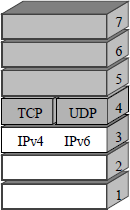Chapter 7
IP Protocols

This chapter starts the section of the book dedicated to Internet network protocols. It covers the network organization and level 3 protocols (IP and associated protocols). This chapter also deals with the new version of the IP protocol, called IPv6. Chapter 8 will present level 4 protocols: UDP (User Datagram Protocol) and TCP (Transmission Control Protocol); and Chapter 9 the methods used to link the different protocol layers (ARP, RARP, DNS).
7.1. Implementation of the TCP/IP protocols
The IP protocol transfers data in datagram mode, i.e. packets are processed independently. This allows us to have relatively simple and fast equipment within the network. The protocol was designed to ensure the routing and segmentation of data (adaptation of packet length to the size of data carried by level 2 frames).
The goal of the IP protocol is to be able to build a worldwide network by adapting to every type of physical medium. RFCs defining the encapsulation rules of IP packets are:
— Broadcast local network such as Ethernet (RFC 894, see Chapter 3, page 37).
— Point-to-point links with PPP (see Chapter 16).
— Traveling pigeons (RFC 11491);
— X.25 (RFC 1356);
— Frame relay (RFC 1490, see section 15.3);
— ATM (RFC 1483, RFC 1577);
— SDH (RFC 1619);
— WiMAX (working group 16 ng);
— DVB (working group ipdvb);
— Sensor networks (working group 6 lowpan);
— Etc.
In a network, ...
Get Local Networks and the Internet: From Protocols to Interconnection now with the O’Reilly learning platform.
O’Reilly members experience books, live events, courses curated by job role, and more from O’Reilly and nearly 200 top publishers.

